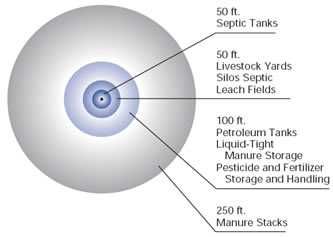Well Siting & Potential Contaminants
Well Siting (Location)
The safety and effectiveness of a well depends greatly on its location.
It is important to maintain safe distances between private ground water wells and possible sources of contamination.
Possible sources of contamination and minimum distances from wells include:

- Septic Tanks, 50 feet from well
- Livestock yards, Silos, Septic Leach Fields, 50 feet from well
- Petroleum Tanks, Liquid-Tight Manure Storage and Fertilizer Storage and Handling, 100 feet from well
- Manure Stacks, 250 feet from well
Potential Contaminants
Ground water can become unusable if it becomes polluted and is no longer safe to drink. Contaminated ground water can be the result of:
- Microbial contamination (fecal contamination from feedlots)
- High concentrations of naturally-occurring contaminants, such as arsenic and radon (depends highly on the geology of the land surrounding the well)
- Local land use practices (fertilizers and pesticides)
- Problems with the integrity of nearby on-site septic systems
To learn more about possible well water contaminants, or if you suspect your wellwater might be contaminated, visit our diseases and contaminants page.
Septic Tanks
One of the most common sources of well water contamination are failed septic tanks or septic systems. For information on private well water and septic tank considerations, please visit:
- Your Septic System (Water Systems Council) [PDF - 34KB]
- Septic Systems (National Ground Water Association)
- Septic Systems - What to Do After the Flood (Environmental Protection Agency)
- Septic Systems - SepticSmart Home (Environmental Protection Agency)
- Page last reviewed: April 10, 2009
- Page last updated: April 10, 2009
- Content source:


 ShareCompartir
ShareCompartir